tea brewing guide
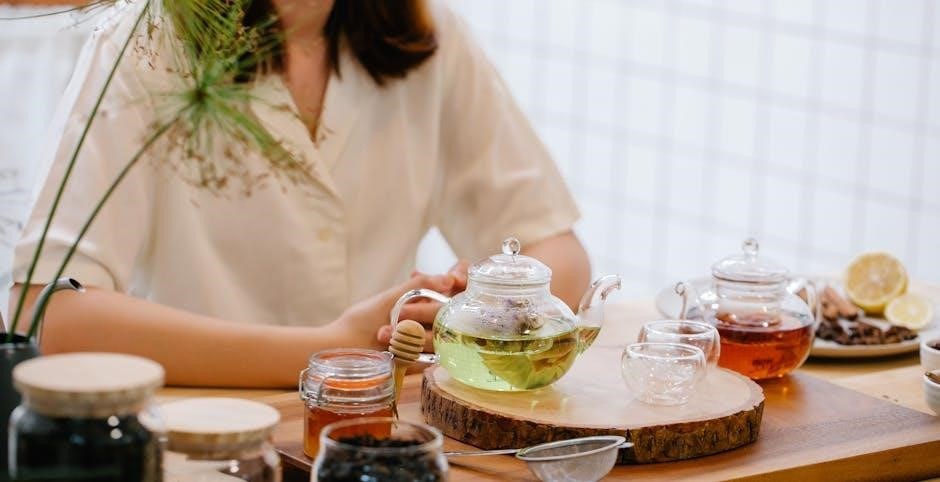
Brewing tea is an art and science that combines personal preference with precise techniques. This guide explores essential steps, tools, and tips to craft the perfect cup, emphasizing flavor, aroma, and customization. Proper temperature, time, and equipment ensure a delightful experience, making every sip a reflection of your unique taste. Whether you’re a novice or an expert, this comprehensive guide will elevate your tea-brewing skills and appreciation.
The Art and Science of Brewing Tea
Brewing tea harmoniously blends creativity with precision, making it both an art and a science. The process involves understanding water temperature, steeping time, and tea quantity, while allowing room for personal expression. Experimenting with techniques and tools enhances the experience, ensuring each cup reflects individual taste. This balance of technical skill and artistic flair elevates tea brewing from a routine to a mindful, enjoyable craft. Mastering these elements fosters a deeper appreciation for the intricate nuances of tea.
Why Proper Brewing Matters
Proper brewing ensures the full flavor and aroma of tea are realized, balancing strength and delicacy. Incorrect techniques can lead to bitterness or a lackluster taste, diminishing the experience. Water temperature, steeping time, and tea quantity are critical, as they preserve the tea’s natural characteristics. Proper brewing also enhances health benefits, like antioxidant absorption and detoxification properties. Investing effort into brewing ensures a more satisfying and nuanced cup, making it worth mastering the process for a superior tea experience.
Essential Equipment for Tea Brewing
The right tools elevate your brewing experience. A good teapot, infuser, kettle, and tea cups are must-haves. Additional items like timers, strainers, and pitchers enhance precision and convenience.
Tea Leaves: Loose Leaf vs. Tea Bags
Choosing between loose leaf and tea bags depends on flavor preference and convenience. Loose leaf tea offers richer, more complex notes and aroma, as it allows leaves to unfurl freely. Tea bags, while handy, may lack the same depth due to restricted leaf expansion. Use about one teaspoon of loose leaf per cup or one tea bag for a standard brew. Rinsing loose leaves in hot water before steeping enhances flavor. Both options provide unique benefits, making them suitable for different brewing scenarios and personal tastes.
Water Quality and Temperature Control
Water quality and temperature are crucial for optimal tea flavor. Use filtered water to avoid impurities that can alter taste. Black teas thrive at 100°C (212°F), while green and oolong teas prefer 80-90°C (176-194°F). White teas require cooler temperatures, around 80°C (176°F). Adjusting water temperature ensures proper extraction of flavors and prevents bitterness. Rinsing tea leaves in brewing temperature before steeping softens them, enhancing the infusion process. This attention to detail elevates the brewing experience, ensuring a balanced and satisfying cup every time.
Teaware: Pots, Cups, and Infusers
Teaware is essential for enhancing your tea-brewing experience. Teapots, available in materials like ceramic, glass, or Yixing clay, are ideal for steeping loose-leaf teas. Cups should complement the tea’s aroma and flavor, with sizes varying for different tea types. Infusers, whether built-in or separate, allow loose leaves to unfurl freely. Proper teaware ensures even extraction and elevates the ritual of tea preparation, making every sip a delight. Choose tools that align with your tea preferences for the best results.
Additional Tools: Timers, Strainers, and Pitchers
Timers are crucial for precise steeping, ensuring optimal flavor without over-extraction. Strainers or filters help catch loose leaves when pouring, preventing sediment. Pitchers, especially glass or insulated ones, are perfect for serving or chilling tea. These accessories enhance convenience and control, allowing you to adjust brewing parameters. They complement teaware, making the process seamless and enjoyable. Use them to refine your technique and achieve consistently excellent results in every brew.
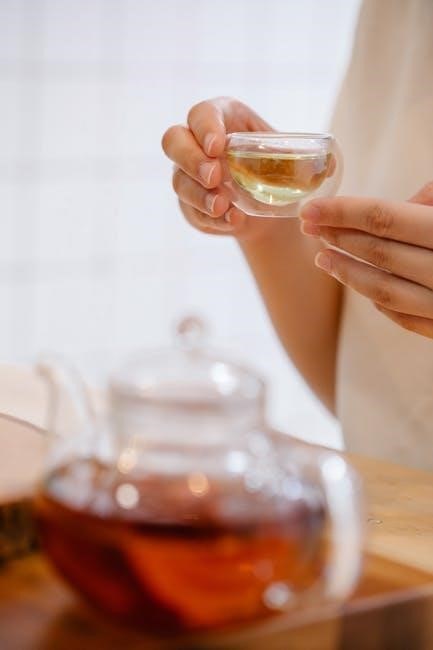
Understanding Tea Types
Exploring tea varieties is essential for mastering brewing. From robust black teas to delicate greens, oolongs, whites, and herbals, each type offers unique flavors shaped by processing methods.
Black Tea: Strength and Flavor Profile
Black tea is renowned for its robust, full-bodied flavor and dark amber color. Its strength varies, offering rich, smooth notes with hints of malt, spice, or fruit, depending on the origin. The astringent finish adds complexity, making it a favorite for those who enjoy bold brews. Popular varieties like Assam, Darjeeling, and Ceylon showcase diverse flavor profiles. Black teas are best brewed with boiling water (200°F-212°F) for 3-5 minutes, bringing out their characteristic strength and depth. Pair with milk or sugar for a classic experience.
Green Tea: Delicate and Refreshing
Green tea is celebrated for its light, refreshing taste and vibrant aroma, offering a delicate balance of grassy, floral, or vegetal notes. Its subtle flavor profile makes it a perfect choice for those seeking a soothing, caffeine-light brew. To preserve its natural essence, green tea is best brewed at lower temperatures (160°F-170°F) for shorter steeping times of 1-3 minutes. Popular varieties like Sencha, Dragon Well, and Matcha showcase its versatility, providing a crisp, clean finish that invigorates the senses and promotes relaxation.
Oolong Tea: Partially Fermented Complexity
Oolong tea offers a unique, smooth profile due to its partial fermentation process, blending floral, fruity, and honey-like notes. Its complexity shines with temperatures between 80°C-90°C and steeping times of 3-6 minutes. This tea is perfect for those seeking a balanced, aromatic brew. Multiple infusions are common, with each steep revealing new layers of flavor. Oolong’s versatility and refined character make it a favorite among tea enthusiasts, providing a delightful experience that combines the subtlety of green tea with the richness of black tea.
White Tea: Minimal Processing and Subtlety
White tea is renowned for its delicate flavor and minimal processing, preserving its natural essence. Harvested from young tea buds, it offers light, floral, and slightly sweet notes. Optimal brewing requires water at 80°C, steeping for 1-3 minutes to prevent bitterness. Its subtle aroma and refreshing profile make it ideal for those seeking a gentle, caffeine-light brew. With its clean finish and light body, white tea is a perfect choice for a soothing and tranquil tea experience that highlights its natural simplicity.
Herbal and Fruit Teas: Caffeine-Free Options
Herbal and fruit teas offer refreshing, caffeine-free alternatives, perfect for any time of day. Made from fruits, herbs, and flowers, these teas are steeped in boiling water for 5-7 minutes, depending on desired strength. Their vibrant flavors and aromatic profiles range from fruity to floral, providing a soothing and healthy choice. Rich in antioxidants and free from caffeine, they cater to those seeking a calming, guilt-free brew. Experiment with diverse blends to discover your favorite, enjoying their natural goodness and versatility in hot or iced preparations.
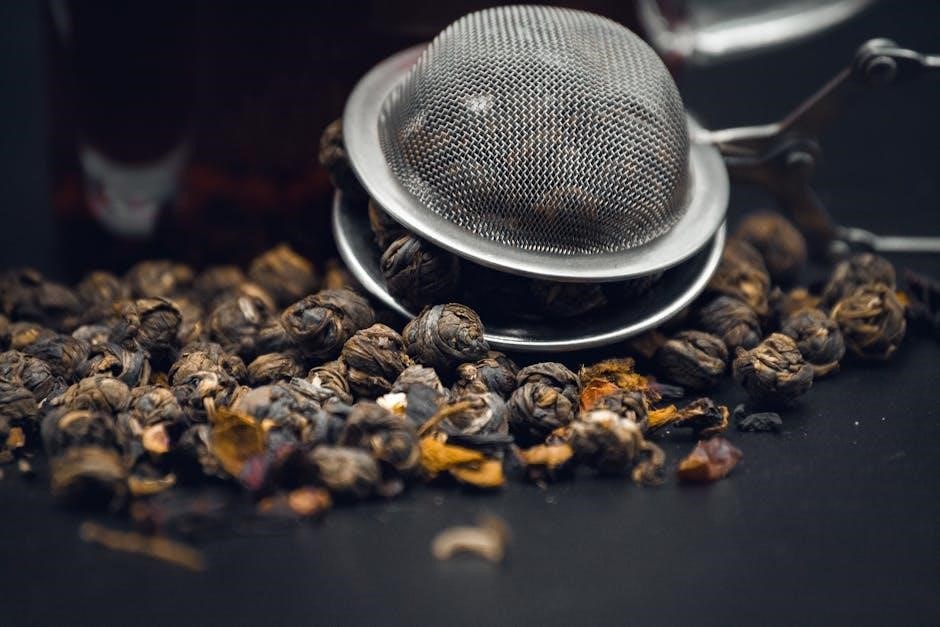
Brewing Techniques
Mastering brewing techniques enhances flavor and aroma. Explore hot and cold methods, each offering unique results. Adjust time, temperature, and tools to suit your preference for the perfect brew.
Hot Brewing: Step-by-Step Guide
Hot brewing is a classic method that brings out the full flavor of tea. Start by measuring one teaspoon of loose tea per cup or using a tea bag. Heat water to the ideal temperature—boiling for black tea, slightly cooler for green or oolong. Pour the water over the tea and let it steep, covering the pot to retain heat. Steeping times vary: 3-5 minutes for black, 1-3 for green, and 3-6 for oolong. Strain, serve, and enjoy! Adjust parameters like temperature and time to suit your taste preferences for the perfect cup. This method ensures a rich, aromatic brew every time.
Cold Brewing: Perfect for Iced Tea
Cold brewing is a refreshing alternative to hot tea, ideal for warm weather. Simply measure 2 teaspoons of loose tea or 2 tea bags per cup of water. Combine in a pitcher, cover, and refrigerate for 3-5 minutes. The longer it steeps, the stronger the flavor. Strain before serving. This method avoids bitterness and dilution, yielding a smooth, flavorful iced tea. Adjust steeping time to your taste for a perfectly balanced brew. Serve over ice for a refreshing, caffeine-free option or add sweeteners as desired.
Factors Affecting Tea Quality
Water quality, temperature, and steeping time significantly impact tea flavor. Using filtered water and precise temperatures ensures optimal taste, while over-steeping can lead to bitterness.
The Importance of Water Temperature
Water temperature plays a vital role in brewing tea, as it directly affects flavor and aroma. Black, dark, and herbal teas thrive in boiling water (100°C/212°F), while green, white, and oolong teas require cooler temperatures (80-90°C/176-194°F) to prevent bitterness. Using the right temperature ensures optimal extraction of tea leaves, preserving their delicate qualities. Overheating can burn leaves, leading to a bitter taste, while underheating may result in a weak brew. Adjusting temperature according to tea type is essential for a perfect cup.
Steeping Time: Finding the Perfect Balance
Steeping time is crucial for achieving the ideal balance of flavors in your tea. Black teas typically require 2-4 minutes, green teas 1-3 minutes, oolong teas 3-6 minutes, and white teas 2-4 minutes. Over-steeping leads to bitterness, while under-steeping results in a weak brew. Adjust steeping time based on personal preference and tea type. For herbal teas, steep for 5-7 minutes to release full flavors. Correct steeping ensures a harmonious extraction, enhancing the tea’s natural characteristics and delivering a satisfying experience.
Measuring Tea Leaves: The Right Amount
Measuring tea leaves ensures a balanced brew. Use about one teaspoon of loose-leaf tea per 8 oz of water. Adjust based on leaf size and desired strength. For tea bags, one bag per cup is standard. Too little may result in a weak brew, while too much can cause bitterness. Experiment with proportions to tailor flavor to your preference. Proper measurement enhances aroma and taste, making it a cornerstone of successful tea brewing.
Advanced Brewing Methods
Explore traditional techniques like Gongfu and Japanese Matcha preparation. These methods use specialized tools and multiple infusions to refine flavor and aroma, offering a deeper tea experience.
Gongfu Brewing: Traditional Chinese Method
Gongfu brewing is a traditional Chinese method emphasizing precision and ritual. It uses small Yixing teapots to enhance aroma and flavor. The process involves rinsing tea leaves, then brewing in short infusions, allowing the tea’s profile to evolve. This method highlights the nuances of oolong, pu-erh, and other complex teas. Water temperature and leaf quantity are carefully controlled. The ritual fosters mindfulness and connection to China’s rich tea culture, making it a cherished experience for tea enthusiasts seeking depth and authenticity in their brews.
Japanese Matcha Preparation
Japanese Matcha preparation is a centuries-old ritual requiring precision and mindfulness. Sourced from shade-grown green tea, Matcha is finely ground into a vibrant powder. Using a bamboo whisk (chasen) and ceramic bowl, the process involves sifting Matcha to remove lumps, adding hot water (70-80°C), and whisking in a zigzag motion to create a frothy, emerald-green brew. This traditional method emphasizes the tea’s rich umami, subtle bitterness, and lingering sweetness, promoting a meditative experience and offering health benefits from its high antioxidant content.
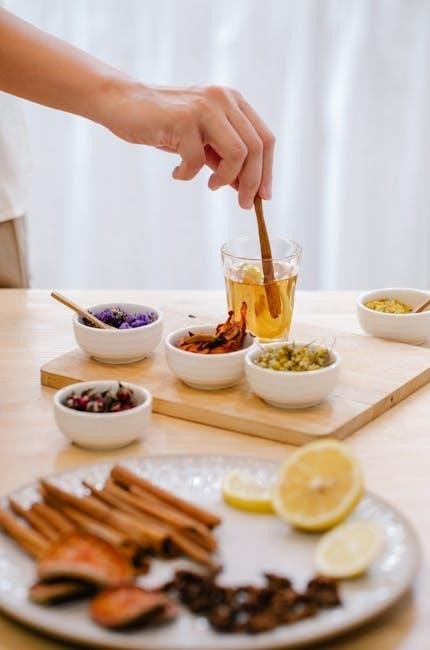
Health Benefits of Brewing Tea
Brewing tea offers rich antioxidants and aids in detoxification by naturally absorbing heavy metals like lead and cadmium, improving water quality and promoting overall well-being through mindful preparation.
Antioxidants and Nutritional Value
Brewing tea unlocks a wealth of antioxidants, including polyphenols, which combat free radicals and support overall health. Tea is rich in vitamins like C and E, and minerals such as potassium and manganese. Green tea, in particular, is renowned for its high antioxidant content, promoting heart health and immune function. Proper brewing techniques enhance nutrient extraction, ensuring maximum benefits. Regular tea consumption can contribute to a balanced diet and improved well-being, making it a nutritious and flavorful addition to daily routines.
Detoxification: Tea’s Role in Removing Heavy Metals
Brewing tea naturally absorbs heavy metals like lead and cadmium, purifying water and enhancing safety. The longer tea steeps, the more toxins are removed, with up to 15% reduction in heavy metals. This process highlights tea’s dual role as both a refreshing drink and a natural water purifier. Regular consumption of brewed tea can contribute to detoxification, supporting overall health and well-being. This unique benefit makes tea a practical choice for daily hydration and environmental health.
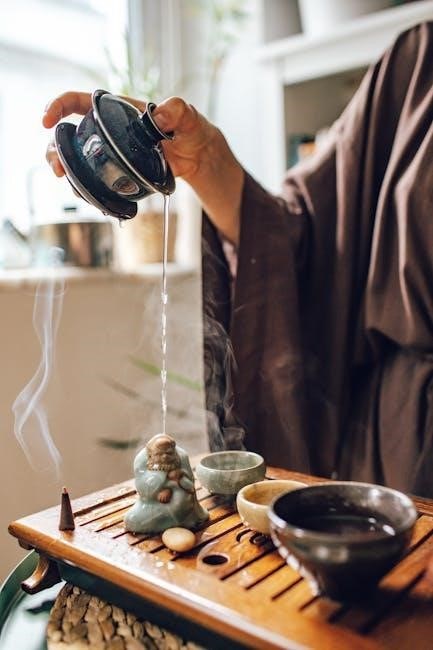
Common Mistakes to Avoid
Common mistakes in tea brewing include over-steeping, which leads to bitterness, using poor-quality water, and incorrect temperatures. Adjusting these factors ensures a balanced and enjoyable cup.
Over-Steeping and Bitterness
Over-steeping is a common mistake that leads to bitter flavors, especially in delicate teas. Steeping times vary: green tea (1-3 minutes), black tea (2-4 minutes), and herbal teas (5-7 minutes). Exceeding these times releases excess tannins, resulting in an unpleasant taste. To avoid bitterness, use a timer and adjust steeping durations based on tea type. For stronger flavors, increase tea leaves rather than steeping time. This ensures a balanced and enjoyable cup without harshness. Proper steeping enhances aroma and flavor, making it essential for a perfect brew.
Using Poor Quality Water
Using poor quality water can significantly impact the taste and aroma of your tea. Impurities, minerals, or chemicals in the water can alter the flavor profile, making it bitter or unpleasant. Always use fresh, filtered water to ensure a clean and balanced taste. Avoid tap water with high mineral content or chlorine, as it can mask the tea’s natural nuances. For optimal results, use water with a neutral pH and minimal impurities to bring out the true essence of your tea leaves. This simple step elevates your brewing experience.
Experimentation and Personalization
Experiment with steeping times, temperatures, and tea quantities to tailor your brew to personal taste. Adjusting these parameters can enhance flavor and aroma, making each cup unique.
Adjusting Strength and Flavor
Adjusting the strength and flavor of your tea involves tweaking steeping time, water temperature, and tea quantity. Longer steeping times intensify flavor, while shorter times yield lighter notes. Water temperature affects extraction—higher temps enhance robustness, while lower temps preserve delicacy. Experiment with tea amounts to balance strength without bitterness. Understanding these variables helps tailor brews to suit preferences, ensuring each cup reflects your ideal flavor profile. Personalization is key to enjoying tea precisely how you like it.
Blending Teas for Unique Flavors
Blending teas allows you to create unique flavor profiles by combining different varieties. Mix robust black teas with delicate green teas for balance, or add floral notes with herbal infusions. Experimenting with proportions and types, such as oolong and white tea, can craft distinctive aromas. Spices and fruits enhance complexity, offering endless possibilities. This creative process lets you tailor flavors to personal preferences, making each blend a reflection of your taste. Blending is an art that expands the world of tea beyond traditional boundaries.
Mastering tea brewing is a journey of discovery, blending tradition and innovation. With the right techniques, tools, and experimentation, every cup becomes a perfect reflection of your taste and creativity.
Final Tips for the Perfect Brew
For the ultimate brewing experience, use high-quality, fresh tea leaves and filtered water. Adjust steeping times and temperatures according to tea type. Experiment with leaf-to-water ratios and brewing methods to suit your taste. Clean equipment regularly to prevent residue buildup. Consider gongfu or Japanese matcha techniques for unique flavors. Store tea properly to preserve aroma. Patience and attention to detail will elevate your brew, ensuring each cup is a delightful reflection of your craftsmanship and passion for tea.